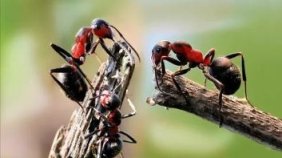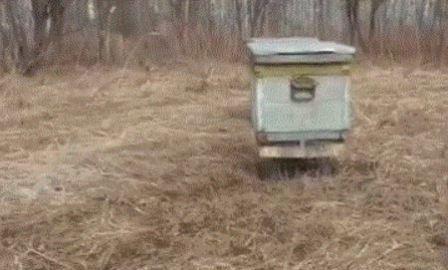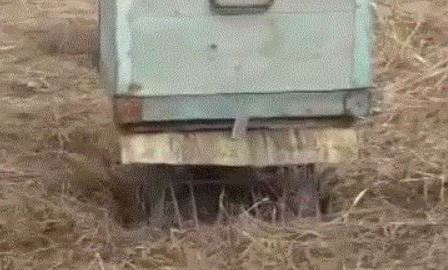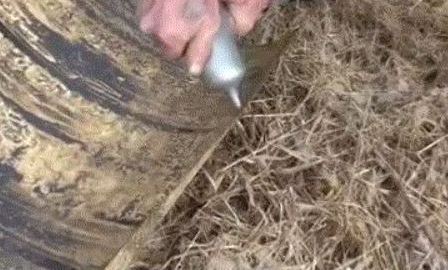How to deal with ants in an apiary or how to get rid of ants in a hive with bees?
 Summer is coming and beekeepers, going out on a migration or in a stationary apiary, especially if the apiary is in the forest, find guests. These guests are ants in the apiary. Beekeepers immediately have questions about what harm ants do in an apiary, as well as how to get rid of ants in a hive with bees. In this article, we will look at how to fight ants in an apiary, how useful or harmful ants are in an apiary, and much more. Read to the end it will be interesting.
Summer is coming and beekeepers, going out on a migration or in a stationary apiary, especially if the apiary is in the forest, find guests. These guests are ants in the apiary. Beekeepers immediately have questions about what harm ants do in an apiary, as well as how to get rid of ants in a hive with bees. In this article, we will look at how to fight ants in an apiary, how useful or harmful ants are in an apiary, and much more. Read to the end it will be interesting.
Content
- Ants in the apiary
- What harm does ants cause in apiaries and beehives?
- Do ants attack bees?
- Benefits of ants in the apiary
- How to deal with ants in an apiary?
- How to get rid of ants in a hive with bees using herbs?
- Walnut leaves for ants
- Prevention and control measures for ants in the apiary
- Summarizing ants in a hive with bees what to do
Ants in the apiary
What kind of ants are there in the apiary? So, who are ants and what do they look like, which ants are the most frequent guests in the apiary. What is more harm or benefit from ants in an apiary? Let's look at all these questions before moving on to the question of ants in a hive with bees, what to do.
Ants in the apiary are insects without wings; only females and males have wings during the mating period, only at this time they are winged.
The ant's head has gnawing organs. The abdomen is connected to the chest by a thin stalk. Ants have a stalk-like abdomen with one or two rings. Their size and external color depend on the species.
What ants are most common in apiaries? Ants in the apiary and in beehives are most often found garden or black, red forest, dark brown forest ants.
What harm does ants cause in apiaries and beehives?
We can say that ants in the apiary are attracted by the opportunity to settle in hives. If the ants decide that it is necessary to create a branch of the anthill in the hive, then the ants in the hive with the bees create a nest for themselves, for which they drag rotten wood, earth, and various garbage into the hive, from which they make a nest for themselves. When the ants in a hive with bees understand that there is a lot of sweets in the hive, the ants in the apiary and in the hive begin to consider the hive as a food supply for themselves.
Ants in a hive with bees can steal brood and take away honey from the cells. If an anthill gets organized and launches a massive attack on the hive, then the ants can easily carry up to 1 kg of honey from the hive to their anthill within 24 hours.
Do ants attack bees?
Sometimes ants can attack weakened bees that land next to the hive or in the field. But you probably shouldn’t regret it too much. Because, as a rule, the bees that crawl near the hive or in the field are for the most part bees weakened by disease, which are already doomed. Let us repeat, attacks on bees are quite rare, because a bee is still a fairly large insect that is difficult for ants to control.
This is what the negative aspects of ants in an apiary look like, or rather the damage that ants cause in a hive with bees.
Benefits of ants in the apiary
However, it should be noted that ants in an apiary can also be beneficial if the ants cannot get into the hive. The benefits of ants in the apiary are quite large. Ants in the apiary destroy a lot of small harmful insects, which can also be enemies of bees or carry diseases between bee colonies. The most important thing is that the ants do not enter the hive with bees. In this case, the benefits of ants in the apiary are greater than the harm.
And therefore, the problem of how to deal with ants in an apiary must be replaced with how to deal with ants in an apiary in beehives.
How to deal with ants in an apiary?
How to deal with ants in an apiary? The beekeeper does not need to run around with torches and buckets of boiling water through the forest and apiary, and there is no need to destroy anthills in the apiary. Remember, ants collect and destroy many ticks in the forest apiary and its surroundings, including encephalitis, and many other forest pests and bees. If you destroy the anthills, then you will be tormented to fight them yourself. The problem of how to deal with ants in an apiary must be replaced with how to deal with ants in an apiary in hives, i.e. it is necessary to prevent ants from getting into the hive. Moreover, running around with torches and buckets of boiling water through the forest and apiary is fraught with a fire, both in the forest and in the apiary, or accidents with boiling water. There are much simpler and more effective solutions on how to get rid of ants in an apiary.
To do this, you don’t have to wait until the ants get into the hive, identify it as a food source and create a branch of the anthill in the hive with the bees. The beekeeper needs to either worry about how to deal with ants in a hive with bees in early spring, or from the very first day of installing the hives, if you moved to a forest point in the summer.
So, what should ants do with bees in a hive?
What to do if there are ants near the hive and ants climb into the hive, what should I do? First Don't let them into the hive. In the spring after the flyby, if the hives have a removable bottom, the beekeeper replaces the old bottom of the hive with a new, clean one. If the bottom is not removable, then the bottom is simply cleaned in place. This operation can be combined with solving the question of how to get rid of ants in bee hives.
 Ants appeared in the apiary, how to deal with them
Ants appeared in the apiary, how to deal with them
The way to fight ants in a hive with bees is simple; the beekeeper needs a sheet of roofing material, which is slightly larger in size than the bottom of the hive. The edge of a piece of roofing felt is coated with lithol. We make the lithol strip wide and thick; ants will not enter the hive through such a lithol strip.

how to deal with ants in an apiary
When we replace the bottom or clean the bottom of the hive, a sheet of roofing material is placed on the stand, with the greased part down, and the hive on top. If the stand for hives has legs, then lubricate all the legs of the stand with lithol, lubricate them higher up so that the rain does not wash them off with a good layer.
And that’s it, for the season the questions of ants crawling into the hive, what to do or how to get ants out of hives with bees have been resolved, not a single ant will climb into the hive.

how to deal with ants in an apiary in beehives
By the way, for convenience, it is better to buy lithol not in tubes, but in jars; it is more convenient for a beekeeper to work with such lithol.
There is another simple way to fight ants in a hive with bees and protect the hives from ants. To do this, the legs of the hive stands are wrapped in pieces of leather, with the fur facing out. Ants simply cannot get through the fur and the question of how to deal with ants in a hive with bees has been resolved.
How to get rid of ants in a hive with bees using herbs?
But ants in a hive with bees, what should you do if they are already in the hive, how to scare the ants away from the hive? When deciding how to fight ants in a hive with bees, some beekeepers get good results by using tansy grass and walnut leaves to repel ants. Common tansy is a perennial, rather coarse, erect plant up to 1 m tall, forming several stems. Tansy is common in the temperate zone of Russia. It grows on the boundaries of fields, in meadows, in groves, between bushes, near roads and housing, etc.
Tansy is poisonous to a certain extent. According to VILAR, the flowers and leaves of this plant completely paralyze flies within 15 minutes. Tansy is popularly known as a means of repelling insects (flies, fleas) and even replacing naphthalene. At the same time, tansy is a good pollen carrier. Therefore, tansy may well repel ants and help the beekeeper get rid of ants in the hive.
Walnut leaves for ants
Another plant that will help repel ants from the hive is walnut. This is a well-known large tree that is grown for its edible fruits and as an ornamental plant in the southern regions. Walnuts are used in folk medicine, for example, an alcoholic tincture of propolis with walnuts is made.
How to get rid of ants in a hive using walnut leaves? The smell of walnut leaves is also unpleasant to ants. If you find ants near or inside the hive, it is enough to place tansy sprigs or a few walnut leaves under the hive and on the canvas, and in a few hours the ants will leave the hive. This is how you can easily remove ants from hives with bees without destroying the ants themselves.
Tansy and walnut leaves are best used freshly cut, but they can also be prepared. This should be done in dry weather in early July. Dry the plants in the shade, in a well-ventilated area. Store in paper bags.
Prevention and control measures for ants in the apiary
Instead of fighting ants once they have entered the hive, it is advisable to carry out preventive measures to protect the hive from ants.
How to protect a hive from ants was described above, but there are a number of general measures that will help against ants.
So, general advice to novice beekeepers is to periodically mow the grass around the hives. Not only will the ants, using the tall grass, climb into the hive, as if on a ladder, to find something tasty for themselves, and create a problem: ants climb into the hive, what to do. Tall grass is also a pathway through which many other bee pests enter the hive. Therefore, it is so important to periodically mow the grass in the apiary, preventing it from being high and touching the walls of the hives.
Also, beekeepers need to pay attention to the condition of the hives. The question of ants in a hive with bees, what to do, will arise much less often if the hives are intact, without cracks and gaps between the boards. Therefore, hives still need to be repaired on time
.
Summarizing ants in a hive with bees what to do
To summarize, when the question arises: ants in a hive with bees, what to do, it is not necessary to radically fight nature, it is enough to just make a little adjustment and turn the ants in the apiary from a pest into a beneficial insect that will not harm the bees and at the same time will help the beekeeper fight diseases bees, and also bring many other benefits, for example, destroying encephalitis ticks in the forest and other pests.
